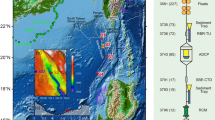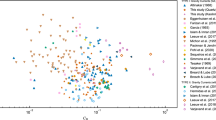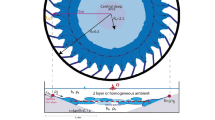Abstract
LABORATORY gravity currents are frequently used to model a range of environmental and industrial flows1. The manner in which these flows become diluted with distance by the surrounding fluid has important implications for turbidity currents2, pyroclastic flows3,4, avalanches5, accidental dense gas releases6, fire propagation7 and emission of industrial pollutants. Here we present an experimental technique for quantifying the entrainment of ambient fluid into the head of a gravity current propagating along a horizontal surface. The technique relies on the neutralization of an alkaline current by entrainment of acidic ambient fluid, and is visualized by using a pH indicator. Dimensional analysis indicates that the proportion of ambient fluid entrained into a gravity current head depends only on the initial volume of the current and distance from the release point, and is independent of the initial value of the density difference. This result is confirmed by the experimental data, which also show that little dilution of the head takes place during the slumping phase8,9. Thereafter the dilution increases with the downstream distance, in quantitative agreement with the predictions of a theoretical model which evaluates the volume of entrained fluid. We apply the results to show that sediment slumps of initially high sediment concentrations will become dilute turbidity currents owing to entrainment of sea water before they have propagated extensively over the floors of ocean basins.
This is a preview of subscription content, access via your institution
Access options
Subscribe to this journal
Receive 51 print issues and online access
$199.00 per year
only $3.90 per issue
Buy this article
- Purchase on SpringerLink
- Instant access to full article PDF
Prices may be subject to local taxes which are calculated during checkout
Similar content being viewed by others
References
Simpson, J. E. Gravity Currents in the Environment and the Laboratory (Halsted, Chichester, 1987).
Allen J. R. L. Principles of Physical Sedimentology (Allen & Unwin, London, 1985).
Wilson, C. J. N. Sci. prog. Oxf. 70, 171–207 (1986).
Sparks, R. S. J. et al. Earth planet. Sci. Lett. 114, 243–257 (1993).
Hopfinger, E. J. A. Rev. Fluid Mech. 15, 47–76 (1983).
Britter, R. E. A. Rev. Fluid Mech. 21, 317–344 (1989).
Emmons, H. W. Proc. 3rd int. Symp. Fire Safety Science (eds Cox, G. & Langford, B.) 249–260 (Elsevier, London, 1991).
Huppert, H. E. & Simpson, J. E. J. Fluid Mech. 99, 785–799 (1980).
Rottman, J. W. & Simpson, J. E. J. Fluid Mech. 135, 95–110 (1983).
Hoult, D. P. A. Rev. Fluid Mech. 4, 341–368 (1972).
Huppert, H. E. J. Fluid Mech 121, 43–58 (1982).
Piper, D. J. W., Shor, A. N., Farre, J. A., O'Connell, S. & Jacobi, R. Geology 13, 538–541 (1985).
Heezen, B. C. & Ewing, M. Am. J. Sci. 250, 849–873 (1952).
Heezen, B. C., Erickson, D. B. & Ewing, M. Deep-Sea Res. 1, 193–202 (1954).
Author information
Authors and Affiliations
Rights and permissions
About this article
Cite this article
Hallworth, M., Phillips, J., Huppert, H. et al. Entrainment in turbulent gravity currents. Nature 362, 829–831 (1993). https://doi.org/10.1038/362829a0
Received:
Accepted:
Issue date:
DOI: https://doi.org/10.1038/362829a0
This article is cited by
-
A framework for validation and benchmarking of pyroclastic current models
Bulletin of Volcanology (2020)
-
Iron diapirs entrain silicates to the core and initiate thermochemical plumes
Nature Communications (2018)
-
Interaction between waves and gravity currents: description of turbulence in a simple numerical model
Environmental Fluid Mechanics (2018)
-
Mixing dynamics of turbidity currents interacting with complex seafloor topography
Environmental Fluid Mechanics (2018)
-
Structure of a dense release produced by varying initial conditions
Environmental Fluid Mechanics (2018)



